The Science Behind Animal Movement and Modern Games 05.11.2025
Building upon the foundational insights explored in The Science Behind Animal Movement and Modern Games, we delve deeper into how the principles of animal locomotion are inspiring cutting-edge robotics and influencing technology beyond entertainment. From the biomechanics of movement to advanced materials and AI, the intersection of biology and engineering offers promising pathways for innovation that can reshape industries and virtual experiences alike.
1. From Biological Inspiration to Mechanical Innovation: Tracing the Evolution of Animal-Inspired Robotics
a. Historical overview of biomimicry in robotics development
The journey of integrating animal movement into robotics dates back to the 1960s, when engineers first attempted to mimic simple locomotion patterns such as walking and crawling. Early prototypes like the MIT Leg Laboratory’s robotic quadrupeds utilized basic joint actuators to imitate animal gait cycles. Over decades, this approach evolved through iterative research, inspired by studies of animal biomechanics, to develop robots capable of complex, adaptive movements. Notably, the 2005 Boston Dynamics BigDog exemplifies how biomimicry combined with modern control systems to create a robust, terrain-adapting robot.
b. Key animal locomotion strategies that have influenced robotic design
Various animals employ unique strategies optimized for their environments. Quadrupeds like dogs and cats utilize gait patterns such as walking, trotting, and galloping, which have directly inspired multi-legged robots capable of traversing uneven terrain. Aquatic animals, including fish and octopuses, drive innovations in underwater robots using jet propulsion and flexible, muscular bodies. Birds and insects, with their wing-flapping and hovering abilities, have informed the development of flapping-wing drones that achieve high agility and energy efficiency.
c. The transition from theoretical models to practical robotic applications
Initially, biomimicry relied heavily on theoretical physics and simplified models. Today, advances in materials science, sensor technology, and control algorithms enable the real-world deployment of animal-inspired robots. For example, soft robotics, which emulate organic tissue flexibility, now allows for safer, more adaptable interactions with complex environments. Additionally, simulations using biomechanical data help optimize robot designs before physical prototyping, reducing costs and accelerating innovation.
2. Mechanical Principles Derived from Animal Locomotion
a. Understanding joint articulation and limb coordination in animals
Animals coordinate multiple joints and muscles to produce smooth and efficient movement. Roboticists study these joint articulations to design actuators that replicate natural limb kinematics. For instance, the complex knee and ankle joint movements in quadrupeds have informed multi-jointed robotic legs that adapt gait patterns dynamically, allowing robots to navigate rough terrain with minimal energy expenditure.
b. Energy efficiency and gait optimization inspired by animal movement
Research indicates that animals optimize their gaits to minimize energy consumption, such as the transition from walking to trotting at certain speeds. Engineers incorporate these principles into robotic gait algorithms, resulting in machines that conserve power while maintaining high mobility. For example, legged robots like ANYmal utilize gait cycle adjustments based on terrain feedback to maximize efficiency, paralleling animal strategies.
c. The role of sensory feedback systems in adaptive robotic locomotion
Animals rely heavily on sensory inputs—visual, tactile, vestibular—to adapt their movement in real-time. Modern robots integrate sensors such as LIDAR, accelerometers, and force sensors to mimic this adaptive ability. Advanced control systems process this data to modify gait, speed, and posture instantaneously, enabling robots to operate effectively in unpredictable environments, much like their biological counterparts.
3. Technological Advances in Replicating Animal Movement
a. Materials and actuators mimicking biological tissues and muscles
Innovations in soft robotics utilize materials such as silicone elastomers, shape-memory alloys, and electroactive polymers that emulate biological tissues. These materials enable robots to perform flexible, compliant movements akin to muscles and skin, providing safer interaction with humans and delicate objects. For instance, researchers have developed robotic tentacles with muscle-like fibers that can grip and manipulate objects with dexterity comparable to octopus arms.
b. Robotics algorithms inspired by animal neural control systems
Neural-inspired algorithms, including spiking neural networks and reinforcement learning, model how animals process sensory information and make movement decisions. These algorithms facilitate autonomous adaptation, enabling robots to learn and optimize locomotion strategies over time. DARPA’s subterranean robots employ such neural-inspired control systems to navigate complex underground environments with minimal human intervention.
c. Integration of sensors and AI for real-time adaptation in robots
The fusion of sensor data with AI-driven control allows robots to adjust their gait and movement dynamically, even in unfamiliar terrains. For example, quadruped robots like Ghost Robotics’ Vision 60 use vision, force, and proprioceptive sensors combined with AI to perform complex tasks such as climbing stairs or avoiding obstacles, mimicking animal agility and situational awareness.
4. Case Studies: Animal-Inspired Robots in Action
| Robot Type | Animal Inspiration | Application |
|---|---|---|
| Spot | Canine quadruped | Rugged terrain exploration, search and rescue |
| Aquabots | Aquatic animals like fish and octopuses | Underwater exploration and environmental monitoring |
| Robird | Insect and bird wing flapping | Aerial surveillance, agile flight in cluttered environments |
These examples demonstrate how biomimicry translates biological principles into practical robotics, enabling machines to perform complex tasks efficiently, adaptively, and safely in diverse settings.
5. Challenges and Limitations in Translating Animal Movement to Robotics
a. Complexity of biological locomotion versus mechanical simplification
Biological systems are inherently complex, involving millions of nerve, muscle, and joint interactions. Replicating this intricacy in mechanical form poses significant challenges, often resulting in simplified models that cannot fully capture natural fluidity and adaptability. For example, current legged robots may lack the nuanced muscle-tendon elasticity that enables animals to conserve energy and adapt instantaneously.
b. Energy consumption and power management issues
Animal movement is highly energy-efficient, thanks to evolved biological mechanisms. Reproducing this efficiency remains difficult; many robots consume substantial power, limiting operational duration. Soft actuators and novel energy storage solutions are being researched to address this, yet a gap persists between biological and artificial energy management.
c. Scaling biological models to robotic prototypes
Scaling down or up biological models often leads to issues in control precision, material constraints, and structural stability. Larger robots face issues like increased inertia, while smaller ones struggle with actuator miniaturization and sensor integration. Overcoming these scaling hurdles is crucial for deploying highly capable animal-inspired robots in real-world scenarios.
6. Future Directions: Enhancing Human Robotics Through Animal Locomotion Insights
a. Developing more autonomous, adaptable robots with animal-like agility
Future robotics will leverage AI and bio-inspired control systems to create machines capable of autonomous decision-making and rapid adaptation. For instance, researchers aim to develop robots with the agility of cheetahs or the climbing abilities of arboreal animals, enabling applications in disaster zones or extraterrestrial terrains.
b. Cross-disciplinary innovations—biomechanics, AI, and material science
The convergence of biomechanics, artificial intelligence, and advanced materials promises breakthroughs in robot design. Combining these fields allows for the creation of robots that learn from biological models, adapt in real-time, and utilize materials that mimic tissue elasticity, leading to more lifelike and efficient movement systems.
c. Potential impacts on industries such as search and rescue, healthcare, and space exploration
Animal-inspired robots could revolutionize multiple sectors. In search and rescue, agile quadrupeds could access collapsed structures; in healthcare, soft robots might assist in minimally invasive surgeries; and in space exploration, adaptable robots could traverse alien terrains, mirroring the versatility seen in nature.
7. Bridging Back to the Parent Theme: The Broader Impact of Animal Movement Science on Modern Gaming and Beyond
a. How understanding animal locomotion informs realistic character animation and physics in games
The detailed study of animal movement enhances the realism of character animations in video games. Techniques such as motion capture combined with biomechanical modeling allow developers to create characters that move naturally, reducing uncanny valley effects. For example, the realistic gait cycles of quadrupeds in AAA titles owe much to research on animal biomechanics.
b. The role of biomimicry in creating immersive, naturalistic virtual environments
Biomimicry principles extend beyond character movement, influencing environmental physics, flora, and fauna behaviors in virtual worlds. This enhances immersion, making virtual environments more believable. Simulations of animal habitats, inspired by real-world biomechanics, help in designing ecosystems that react authentically to player interactions.
c. Extending the principles of animal-inspired movement into virtual reality and simulation technologies
Virtual reality (VR) systems integrate biomimicry by incorporating motion patterns that replicate animal agility, providing users with more natural control and movement. Advanced haptic feedback and motion tracking, grounded in biological principles, improve immersion and user experience, opening new horizons in training, therapy, and entertainment.
The ongoing dialogue between biology and technology continues to inspire innovations that bridge the virtual and real worlds, demonstrating that understanding animal movement not only advances robotics but also enriches our digital landscapes.
Światowy Dzień Zdrowia w Kubusiowym Przedszkolu
Jak mówimy o niepełnosprawności?
W ramach projektu „Jak mówimy o niepełnosprawności”, w ubiegłym tygodniu z okazji 2 kwietnia odbyły się w grupach „Tygrysków” i „Sówek” specjalne zajęcia z pedagogiem specjalnym poświęcone Dniu Świadomości Autyzmu. Spotkanie miało na celu przybliżenie dzieciom tematyki autyzmu w przystępny i angażujący sposób. Zajęcia rozpoczęły się od wspólnego obejrzenia bajki, która wprowadziła dzieci w świat różnorodności i indywidualnych potrzeb.
Proszę nacisnąć czytaj więcej…
Kosmiczna podróż Tygrysków 🚀🐯
Proszę nacisnąć czytaj więcej…
🌸🕊️ Wiosenne przyloty – króliczki poznają ptaki! 🐇🐦
Wiosenne przyloty – króliczki poznają ptaki!
W tym tygodniu króliczki poznały ptaki które wracają do Polski z ciepłych krajów. Dzieci z wielkim zainteresowaniem słuchały opowiadań o różnych ptakach, ich zwyczajach, wyglądzie i co lubią jeść. Podczas spacerów oglądaliśmy zmiany zachodzące w przyrodzie, poszukiwaliśmy złotego deszczu – czyli forsycji. W poniedziałek świętowaliśmy urodziny Lei! Króliczki pięknie odśpiewały koleżance sto lat oraz złożyły życzenia urodzinowe! Jeszcze raz wszystkiego najlepszego Lea!🎉
Proszę nacisnąć czytaj więcej…














